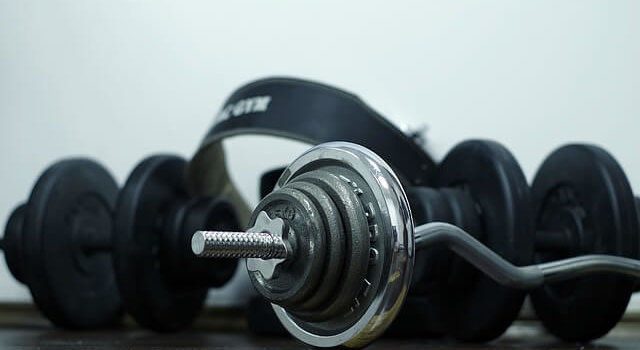no? Then you are giving away potential!
You keep training until you can no longer?
Then maybe you go overboard.
Learn in this article how to properly incorporate muscle failure into your training and what the difference between good and bad muscle failure is.
If you train regularly with your own body weight, then you already know that it is good to go to your limits.
Proper strength training lives from constantly challenging your body.
That you force him to get better.
Because strength training is about getting better.
To get stronger.
So the question is: When is it too much of a good thing?
What is the sweet spot you should achieve during training and do you have to achieve it with every training?
Technical and absolute muscle failure
Let’s first pick the berry from the bush.
In other words, let’s see what muscle failure means.
Muscle failure is a condition in strength training that results in you having to stop your training set because your strength is no longer sufficient to achieve the to overcome existing resistance.
The main reason for this muscle failure is that the energy stores (ATP = adenosine triphosphate) in your muscles are empty and it would take you a few minutes to replenish them. During this recovery phase, your muscle cell also exchanges metabolic products with the surrounding tissue – the waste is disposed of, so to speak, and the supplies are delivered.
Despite the muscle failure, your muscle is not completely fatigued.
Because if, for example, you make the exercise easier and instead of normal push-ups do the variant on your knees, you can probably do a few more. This fact also makes use of the training method of decreasing sets.
So far, so good.
But there is an important distinction between technical and absolute muscle failure.
Technical muscle failure is reached when you can no longer maintain the correct technique of an exercise and you do it
- drifting away in evasive movements,
- work with verve,
- unintentionally takes longer than 5 seconds for a repetition or
- Groaning louder from the exertion than an aircraft makes noise when taking off.
Absolute muscle failure is only achieved when you can no longer even use these tricks. This can rarely be wanted, but based on the marker of the article I would describe this form as “bad muscle failure”.
For the health-oriented fitness athlete, it is completely sufficient to just tackle technical muscle failure. Not even that is necessary in every training session and certainly not in every sentence.
More on that later.
This approach also helps you to internalize the technique of the exercises even better. If you cheat your way through the exercises without having mastered them properly, you are wasting a lot of potential – especially in bodyweight training where the progression comes about by making the exercise more difficult or changing it!
That’s why I advise in my P.A.T. Bodyweight training complete package to only carry out the next level of an exercise when you have mastered the previous level perfectly.
Incorporate muscle failure correctly into your training
When I write about muscle failure, I mean the “good cop” – technical failure.
Let’s take a look at which training methods and training goals you should incorporate this concept into your training and how you can do it.
Before that, a few interesting studies on the subject of muscle failure (English: training to failure):
- Spanish researchers found in 2006 that training to failure in every set of your workout increased the level of catabolic (degrading ) The hormone cortisol increases at rest and the levels of anabolic (Anabole Mischung) growth hormones such as IGF-1 decrease. This suggests that even if your goal is to gain muscle mass, it is not smart to go to technical failure in every training set (see study).
- Same venue – Spain – in 2012: The researchers trained a small group of men in two different ways: once to failure, once below this threshold. Various aspects were examined, with the drastic increase in the metabolic product adenosine monophosphate (AMP) during training up to muscle failure was particularly interesting. An increased level of this nucleotide is synonymous with decreased protein synthesis within the cell, which is not optimal for muscle building (for the study).
What do these two studies tell us now?
First of all: training to the point of muscle failure is exhausting and you shouldn’t do it every time.
Second: You should plan it strategically into your training, as it can definitely help break plateaus and make your muscles stronger (and bigger).
When does training to failure make sense
Especially when we are talking about technical muscle failure, it can still make sense to include it regularly in your training.
By training to the point of muscle failure, higher lactate values are achieved in the muscle than if you do not go to muscle failure – just test it yourself with a few sets of pull-ups – which, according to the current study, contributes positively to muscle growth because it triggers the intramuscular growth factors be.
That doesn’t sound too bad: The problem if you are too fast – e.g. in the first training set – to the point of muscle failure: Your nervous system then had to switch itself on to activate all available muscle fibers.Also beneficial when training up to Muscle failure is that you force your nervous system by the faster fatigue of smaller muscle fibers to recruit the “big boys” – in this case the so-called fast-twitch (fast) muscle fibers. They then respond better to the training with muscle growth. By the way: explosive repetitions – the fastest possible phase of muscle contraction, for example pulling up as quickly as possible when pulling up – are another way to better activate these “big boys” within your muscles.
And your nervous system isn’t exactly known for recovering quickly.
This means that you will lose quite a bit of repetitions in the following sets. Example: Your first set ends with 10 repetitions (you’ve gone to failure), your second set will probably end with 6 to 7 repetitions. If you had stopped at 9 repetitions in the first set, you could almost certainly do 8-9 repetitions on the second – so a larger training volume overall.
It is therefore a good idea to only go to technical failure in the last set. If so, then do it right!
That means: Throw everything you have into the balance and bite your way through until it is really the last, technically correct repetition.
Expanded the concept with other training methods
The classic variant in strength training is the overload method. You choose an exercise, do several sets of it, that’s it.
In some training phases it can make perfect sense to reinvent or expand the concept of muscle failure.

This is done, for example, by decreasing sets or assisted repetitions (forced reps):
- With the decreasing set, you immediately switch to a lighter exercise after reaching muscle failure and continue. Using the example of push-ups: You do push-ups with your legs raised until you can no longer do it. Then switch to the classic push-up on the floor and finally do a few repetitions (until you can no longer) on your knees.
- With assisted repetitions, a partner will help you do a few more repetitions after you have reached muscle failure. Good example of this: pull-ups. You train until you can’t anymore, then a partner lifts you up a little so that you can do a few more repetitions.
If you are in the muscle building phase or looking for a nice finisher for your workout, you should give these training methods a try.
But be careful: Whoever trains so hard, shoots over the target!
The right and wrong exercises for training to failure
In bodyweight training we have the great advantage that no weight can fall on our head, toes or anywhere else when our muscles fail. At least, most of the time.
Above all, Olympic exercises (e.g. snatch, clean and jerk, etc.) and technically very demanding exercises never train to muscle failure – not even to technical level.So the first point right away: If you train with heavy weights – no, I don’t mean your body if you are still a little overweight have – you should be a little more careful.
Particular caution is also required with jumps, throws, new exercises, exercises in the overhead area, heavy barbell exercises and exercises that strain your back – especially when training with additional weights.
In bodyweight training we can leave the church in the village sooner. Whereas there are also some no-gos here. You shouldn’t go to muscle failure, for example, with handstand push-ups and pull-ups (if you can’t get off or jump safely).
For both types of training, it also applies that you do not go to muscle failure with (maximum) strength training in the range of 1-5 repetitions.
You can train almost all other strengthening exercises without equipment to the point of muscle failure, if your training plan and goal allow it. Especially if you do them for 8 or more reps.
Your takeaway
You have now received a lot of information on the subject of muscle failure from me.
But a simple set of rules for quick application would still be cool?
I understand!
Training to failure is too powerful a tool to send you home without specific tips.
So that you can implement this correctly, relatively easily, here again in a fast run to take away with you:
- Training to failure can help you build muscle if you use it carefully and not too often.
- In any case, you shouldn’t go to failure with every training set.
- If you want to use the training to failure in your training plan, then focus on the last set of an exercise. Here you give it your all!
Don’t forget to vary your training from time to time – always only training the overload method with training until muscle failure in the last set is not a good idea either. Here you will find other training methods, here my free training plans, in which I have already incorporated the methods for you, and here my complete P.A.T. Bodyweight training that contains all of my knowledge. - If you use training methods such as decreasing sets or assisted repetitions, plan a little more recovery after the training units, so you would otherwise do it and do not use these training methods all the time, but sprinkle weeks into a training plan.







